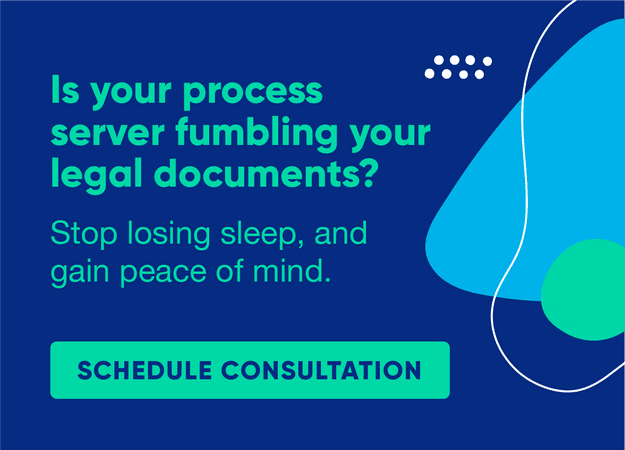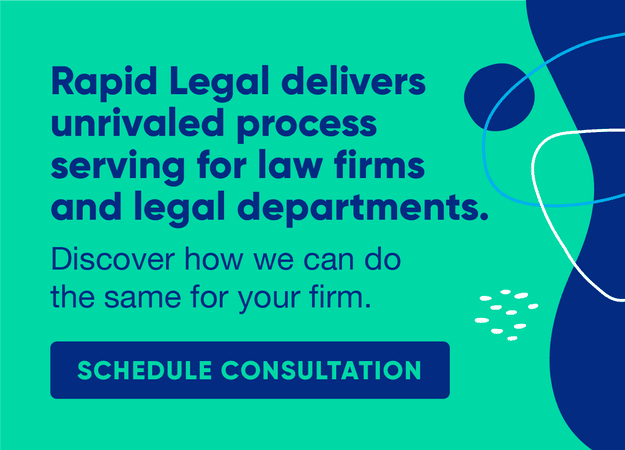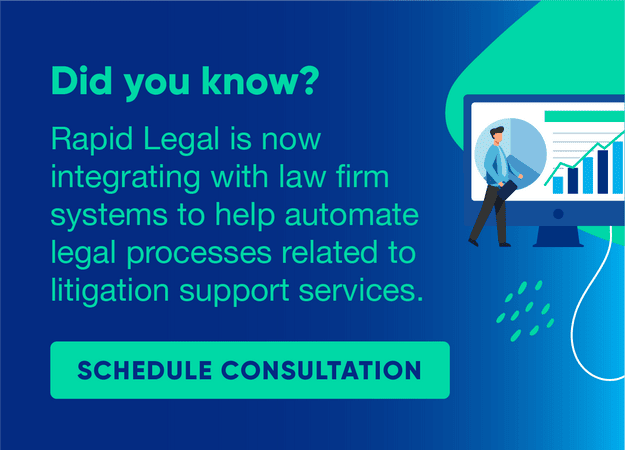Proof of Service Boot Camp: What Every Legal Professional Should Know
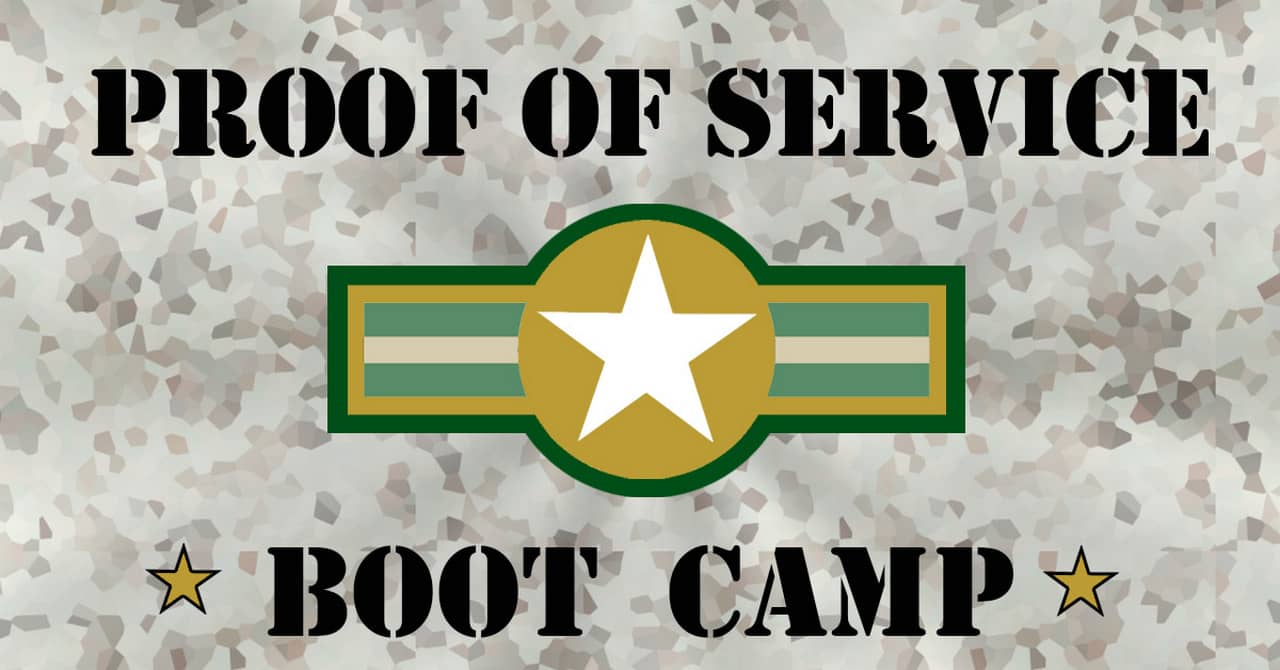
Proof of service is a small thing that makes a huge impact on a legal matter—especially if it’s not done correctly. We’ve designed this fact-packed crash course to build your proof of service expertise with the effectiveness of a Marine Corps boot camp, but without the push-ups and drill sergeant culture.
Without moving from your comfy chair, you’ll be razor sharp in no time about:
- What proof of service means for trials.
- How proof of service relates to service of process.
- Deadlines for filing proof of service.
- When proof of service is considered complete.
- Handling proof of service when court papers can’t be served.
Think you’re ready? OK, recruit, let’s move out!

Proof of service in a nutshell
When you make an important purchase, you always ask for a receipt. It’s the same with proof of service, which functions as a sworn statement that confirms court documents have been served on a party.
A proof of service form (sometimes referred to as a proof of service affidavit) records the name of the person served as well as the time, date, and location where the documents were served. The form describes the types of documents served, the way they were served to the party, and the process server’s name and signature.
Proof of service also acts as a failsafe device. In the event a defendant claims his or her papers were never served, proof of service says differently.
Now that you’ve got the basics, let’s put proof of service into context with its parent action: service of process.
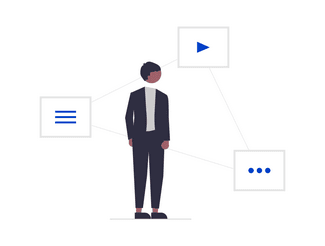
What does ‘service’ mean?
For legal professionals who are new on the job or haven’t worked in litigation, here’s a quick primer about service of process. If your journey through this boot camp goes no further than this paragraph, this is an essential takeaway:
Service of process establishes jurisdiction.
Unless a court has jurisdiction over the party or parties involved in a legal matter there can be no trial.
For the party being sued, service accomplishes three things:
- Explains what the plaintiff is asking for.
- Establishes date, time, and place of the trial.
- Instructs the defendant about how to respond (i.e., explains choices).
Service of process uses specific types of court documents to launch legal matters, including trials. To help you visualize the relationship between these documents and their case types be sure to note Table 1 below.
Table 1.
Case initiating document
| Case type
|
Although there are some exceptions, all these documents must be personally served to the defendant or respondent before anything can proceed.
Documents such as discovery requests and discovery responses are not filed with the court, so the proof of service for these documents is not filed after the papers are served. The proof of service should, however, be signed for the law firm’s own records.
Wouldn’t it be nice to tackle two jobs at the same time?
File and serve allows you to simultaneously submit a file order and a service of process in just a few easy steps through an online portal:
- Upload the conformed copies as soon as the documents are filed.
- If the conformed copies are not readily available, request them from the provider.
- Know the service level of the serve order.
- Verify the documents.
It’s easy to start using file and serve today. Call now for details! (909) 664-9565.
Which type of service?
There are several ways to conduct service of process but two of the most common ways are personal service and substituted service.
- Personal service occurs when an individual gives court documents directly to the party being sued or to the agent authorized to accept service (this may be a business or public entity).
- Substituted service occurs when an individual gives the papers to an adult where the party named in the suit lives, works, or receives mail (including a private post office box, but not a U.S. Postal Service P.O. Box).
Check out The Ultimate Guide for Process Serving to see the full range of service of process methods. The guide is packed with ideas law firms can use to get greater value from service of process, including how to find out where you may be losing money on service of process orders.
Does my document have its own proof of service form?
If you’re uncertain whether a document used in a matter you are handling has its own proof of service form you can find out by checking with the court requirements.
If your document is not paired with its own proof of service form, you may use a general proof of service by mail form.
Watch this video for the step-by-step instructions to fill out a General Proof of Service by Mail form. If you use this form, be sure to give it scrupulous attention, though, because completing this form incorrectly may delay a matter or cause it to be dismissed.

When is proof of service complete?
The parties were located, documents handed over, now the matter may proceed, right?
Wrong.
After court documents have properly been served, the person who served those documents must complete and sign a proof of service affidavit, which attests to the service. That affidavit in turn is filed with the court.
This breakdown may help you more easily visualize the proof of service workflow:
- After papers are served the person who served the papers files a Form SC-104 Proof of Service with the court clerk.
- If the server used an alternate form, they must note each paper served on the alternate form.
- If service was completed by a registered server, the server must file the original proof of service directly with the court and mail you a copy of the filed form. That form may be taken to court and used as needed.
Remember: The original completed Proof of Service form must be filed 5 days before the trial.
If your proofs of service are taking too long to come back or seem less than rock solid use these 9 Questions to Ask a Process Serving Company to find out whether your vendor is up to the job.

Personal service doesn’t always work
Some parties will go to great lengths to avoid being served court papers. Divorce cases are one example where this scenario may play out. Once a server has exhausted the avenues of personal service set by the local court rules, substituted service may be used.
When such circumstances occur, the server provides proof of service using the following steps:
| 1. Write up a “Declaration of Due Diligence”. | This document details every attempt made to serve the papers in person. It should include the dates he or she went to the house or work, times of day, and the result (for example, “No one answered the door” or “Party not in the office”). |
| 2. Server signs this document under penalty of perjury. | There is no form for this, but the server can use a Declaration (Form MC-030). Some local courts may have a form to help with this step. |
| 3. Server fills out a Proof of Service. | This should detail when, where, and how the papers were served. The server must be sure to write the name of the person with whom he or she left the papers with (or a detailed physical description). The server signs the Proof of Service and returns it to you, with the Declaration of Due Diligence, to file in court. |
Substituted service is complete 10 days after the day the papers are mailed.
Other types of substituted service include:
- Service by Notice and Acknowledgement of Receipt
- Service by posting on the premises and mailing (for eviction cases only)
- Service by publication
- Service by posting (at the courthouse)
The proof of service methods these types of substituted service require are detailed on this California court website page.
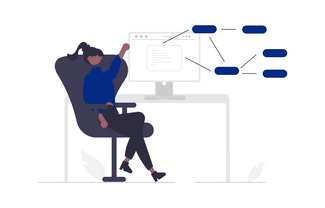
Proof of service the easy way
No legal professional wants to spend the day wondering whether service was successfully completed.
Fortunately, there is an easy way to know as quickly as possible when service has been effected and that proof of service has been filed with the court: Use a qualified service of process provider.
Rapid Legal, for example, generally returns the proof of service within 2-3 business days from the date service takes place. Legal professionals who use Rapid Legal’s service of process receive an alert directly in their email inbox notifying them that service has been completed. This means they spend less time following up with vendors and worrying about their order status.
A range of service levels is available to meet the needs of a particular service of process order. They include:
| Standard | Document(s) scheduled to be dispatched for service on the next business day and will be attempted every 5 days thereafter. |
| Priority | Document(s) is scheduled to be dispatched for service on the next business day and will be attempted every other day thereafter. |
| Urgent before deadline (1:00 p.m.) | Document(s) scheduled to be dispatched for service same day and will be attempted every day thereafter. If the 4-hour time to serve is available, the customer can select the on demand service level, this is to be immediately dispatched for service and attempted within the 4 hour time to serve. |
| On demand | After deadline or within the 4-hour time to serve. |
| (Out of State) Urgent after 10 a.m. deadline | Document(s) scheduled to be dispatched for service on the next business day. |

Mission accomplished
Congratulations! You’ve graduated boot camp and have the skills you need to work your way through proof of service questions. You also have a better understanding of how proof of service fits in the service of process ecosystem.
Now it’s time to put Rapid Legal’s best-in-class performance to work for you. Make your move today to start receiving court-stamped documents and proofs of service fast, and reliably, with our portal that was designed to deliver maximum speed and accuracy.
Book a demo or schedule a call with an account manager now!
5 Secrets to Successful eFiling

Table of Contents
- To perform at your best, use the best
- Surround yourself with experts
- Know the rules, follow the rules
- Be a format fanatic
- Keep a clear head
Ever wonder why some legal professionals seem to have better eFiling experiences than others? Do you wish you could sneak a peek at their tools or decode the behaviors that set their work apart?
Your wish is about to come true.
We’ve worked with countless high-performing eFilers for years and observed what makes this population stand out. If your eFiling rates need a boost or if you want to break out of an eFiling plateau, use these insights about the tools high performers use and how they apply them.
While some practices may seem like things you already do, you are likely to find subtle yet important differences that generate next-level performance. So be sure to read the article closely.

1. To perform at your best, use the best
It takes time to build excellence. Psychologists argue that 10,000 hours of practice are required to develop the highest levels of expertise (known as the 10,000 Hour Rule). However, no one who works in a law firm has 10,000 hours of non-billable time available to perfect their eFiling skills.
So, how do you get there from here?
Take a shortcut.
Partner with a litigation support service provider whose eFiling technology has done the 10,000 hours for you. If you’re not sure how to recognize that kind of technology here are three features it must deliver:
| Automated alerts These reduce human error and let you know about mistakes that may cause the court to reject your eFiling. | A single user portal From a single point, this feature allows you to eFile, order physical filing and service of process, and gain online access to many other litigation support services. Use the portal to submit your eFiling and eService securely anytime from anywhere. | Online fee calculator This feature tells you exactly how much you’ll pay up front. It will help prevent an eFiling rejection for an incorrect payment amount and also help make sure your accounting team doesn’t have any billing surprises at the end of a matter. |
Top-tier technology should also give you the option to file electronic court documents yourself or turn over your order to an eFiling expert. Be sure to investigate how Rapid Legal’s Self-Service and Concierge Service can fill the eFiling gaps for your specific situation.

2. Surround yourself with experts
Legal professionals work in fast-paced, high-demand environments. That’s why the most successful eFilers don’t hesitate to call in an expert reviewer as a “secret weapon” to provide extra coverage and minimize the risk of rejection.
The expert reviewer’s mission is to scrutinize legal documents that may be complex or need hands-on, personalized attention. Rapid Legal’s Expert Review service covers both of these objectives with an audit that helps prevent documents from landing with the 10-15% of eFilings courts reject.
The expert review audit for document formatting and assembly provides:
- Checks to verify that documents are not password-protected or corrupted.
- Visual confirmation that font size and style are correct.
- Assurance that document pages are paginated correctly.
- Confirm that the summons matches the complaint.
- Verify that all mandated forms are attached.
- Review all exhibits to make sure they are electronically bookmarked.
- Confirm that text is text-searchable.
Expert review can also help protect against eFiling rejections by digging deep into document details and to confirm:
- Signatures and dates appear as required.
- Court locations and addresses appear correctly.
- Names and parties match on the documents.
- Case numbers match and documents are confirmed (where applicable).
- Document titles are correct.
- Verify that correct document titles have been selected so that fees are paid to the court correctly.
Need the ultimate in confidence and convenience for your eFiling?
Concierge Service is the solution.
We handle all the details with one easy call. Find out how.
3. Know the rules, follow the rules
Pablo Picasso was famous for ignoring traditional art rules. To be fair, Picasso earned international fame by flouting those rules to create cubism.
Court filings, however, are not art so don’t be like Picasso.
Follow the local court rules to the letter.
It sounds simple but complying with court rules is not as easy as it sounds. That’s because court rules change routinely, including rules regarding deadlines, fees, and document formats. Every court has different rules which makes following the rules an even greater challenge.
The secret to staying on top of court rules is to make sure you stay informed about court activity. To do this, highly successful eFilers align themselves with good information sources and partner with a litigation support service provider that has relationships with the courts and the courts’ own technology providers.
Rapid Legal helps law firms stay abreast of the rules by communicating with them regularly through several different channels:
- Breaking court news, time-sensitive developments, and major change announcements shared via dedicated emails and social media.
- Regular updates in our monthly newsletter that share eFiling go-live dates, changes in court office hours, contact information, upload requirements, and other court news.
- Tips and reminders for working with California courts appear on Rapid Legal’s LinkedIn and Facebook pages.
You can also keep up with rule changes by checking your county’s rules and consulting these resources and useful court links.
The infographic below can help you visualize how electronic court filings flow from the eFiling user, through the courts, and back. Use it to visualize who the stakeholders are in the eFiling workflow and the technologies involved in this process.
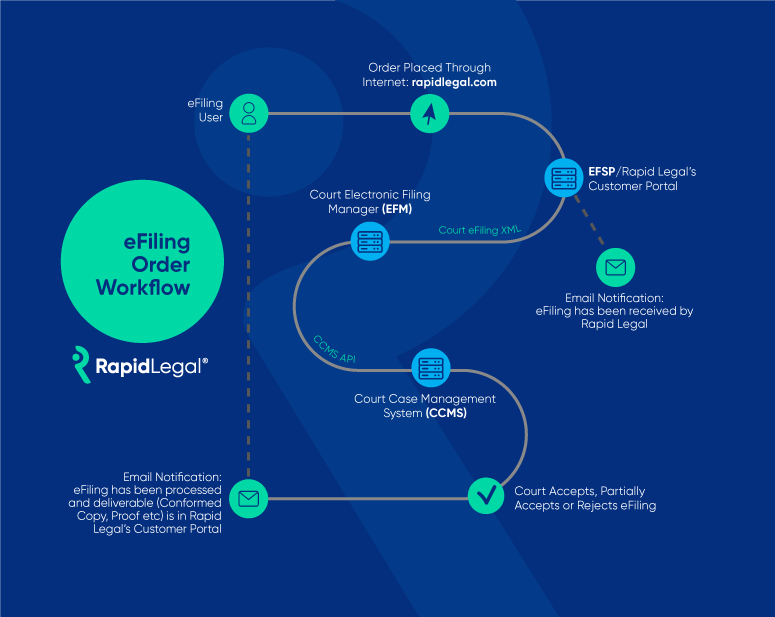
4. Be a format fanatic
The most successful eFilers have made a strategic commitment to never cut corners on small things that make a big difference. Document formatting is one of those things. It matters because the proper formatting and procedure for including exhibits as well as other types of attachments varies across the courts. If you get it wrong you get rejected.
For example, San Francisco Superior Court requires parties submitting exhibits as part of a proposed order, stipulation and order, judgment, or verdict, to upload everything as one document.
In contrast, Los Angeles Superior Court requires parties submitting accompanying documents to a single pleading or law and motion item to eFile each item as a separate PDF document.

Bone up on bookmarks:
If you’ve ever watched a cake collapse while it’s baking in the oven you’ve seen for yourself how getting one thing wrong can wreck an entire project. The same can be said about bookmarks.
For most legal professionals who do eFiling, a bookmark may seem like an incidental part of the electronic court filing process. In fact, few things send an eFiling to the rejection bin with the speed and certainty of bookmarks that are overlooked or done incorrectly.
To make sure a bookmark flaw doesn’t trip up your efiling you need to know these two rules:
1. Exhibits filed electronically must include electronic bookmarks with links to the first page of each exhibit and bookmark titles that identify the exhibit number or letter and briefly describe the exhibit. From: California Rules of Court, rule 3.1110(f)(4)
2. Each electronic document must include an electronic bookmark to each heading, subheading, and the first page of any component of the document, including any:
|
|
|
From: California Rules of Court, rule 8.74(a)(3)
Bookmark Pro Tip
Each electronic bookmark must briefly describe the item to which it is linked.
Example:
An electronic bookmark to a heading must provide the text of the heading, and an electronic bookmark to an exhibit or attachment must include the letter or number of the exhibit or attachment and a brief description of the exhibit or attachment.
Never eFile without this one important thing
An electronic appendix must have bookmarks on the indexes and the first page of each separate exhibit or attachment. Exhibits or attachments within an exhibit or attachment must be bookmarked. All bookmarks must be set to retain the reader’s selected zoom setting.

5. Keep a clear head
You probably didn’t see this one coming: Being calm and relaxed helps legal professionals maintain focus during hours of detail-oriented, deadline-driven work. To help you stay clear and relaxed throughout your workday we’ve gathered these Simple Meditations for the Busy Legal Professional for you to use.
Nothing special is required to perform these 7 exercises. They’re perfect for the office or outdoors and can be done discreetly so most people will be unaware you’re performing them.
Each meditation can help you reduce stress and hone traits such as focus, creativity, empathy, and listening. If you’re wondering how to begin you can start small by spending a few minutes on them every hour or so throughout your workday. Then, increase as needed.

Let’s talk!
It’s no secret that achieving an extremely high eFiling rate is good for you, good for the courts, and good for your clients. Stop waiting to notch up your success and contact Rapid Legal to discover how our industry-leading technology platform and personalized customer care can move you closer to your eFiling goals.
While you’re connecting with us be sure to ask about our satisfaction guarantee: If service is not done right, it’s free.
Make today the day. Schedule a call or request a demo with one of our dedicated account managers now to learn what Rapid Legal can do for you.
The Evolving Landscape of
Litigation Support Service Providers

Exciting developments are happening in the legal industry. And these changes are requiring a new breed of litigation support service providers that can adequately support today’s modern law firm and corporate legal department. Read on to learn:
- How the litigation support service provider industry is changing
- How this is impacting law firms
- What law firms should look for and avoid
- And how law firms can best leverage a strategic partner in litigation support services to gain maximum value; especially those law firms that are particularly keen to modernize or run their firm more like a business, which we see happening more and more every day.
How the Litigation Support Service Industry is Changing
Innovation, disruption, and digital transformation have now fully penetrated the legal industry – from the courts to the law firms down to the vendors + suppliers. If we can find a silver lining in the Covid-19 pandemic, it would be the acceleration of these trends that are serving to modernize the industry.
As a result of this digital transformation, an explosion of customer and business data is being created and used for metrics, reporting, and insights. And more and more law firms are leveraging this data to improve their competitive advantage and the business side of law.
Case Study:
Courts are implementing various digital technologies to automate processes and increase access to justice. eFiling couldn’t have arrived soon enough during these times. Courts that already had implemented it were able to return to court operations and productivity while others who hadn’t struggled to cope.
Quick Fact: Prior to the pandemic, approximately 20 county courts had implemented eFiling. As of summer, 2022, that number stands at 30, with an additional 6 county courts on the way during 2023. With a total of 36 counties implementing eFiling, that will mean almost 60% of the state’s 58 county courts will be eFiling.
Law firms too have increased their adoption of technology as they seek to comply with changing court rules, modernize their practices and/or prepare for the future needs of their firms. Indeed, law firms are realizing the value of system integrations, process automation, data and analytics to improve their business of law.
Because the demand for legal tech is increasing, legal tech vendors with the right software and hardware are cropping up ready to support the technological needs of the legal industry.
Ready to quick-start your law firm’s digital transformation initiative?
Read How to Map Out Your Law Firm’s Digital Transformation and learn the step-by-step process to make it happen.
Bottomline: The litigation support service industry is changing due to the dynamics of the legal market changing.
And speaking of this change; as law firms engage in digital transformations and modernize their business practices, this is requiring a new breed of litigation support service providers that can adequately support today’s modern law firm.
And what we see is that innovative thinking and technology are bifurcating the litigation support service provider landscape into one that is distinguishing between strategic partners and transactional vendors, also known as, traditional attorney service firms.
Want the eBook version of this article?
| Innovative thinking and technology |  | Distinguishing strategic partners from transactional vendors |

For law firms to reap the strategic advantages litigation support service providers can offer them, they must be able to discern and select a strategic partner. The differences that legitimately separate strategic partners from the field of transactional vendors may not be readily apparent on the surface.
What’s the Difference?
Transactional Vendors | |
Value Creation Goal: | Order-based and narrow organizational focus |
Timeframe: | Short to medium term (1-3 years) |
Stakeholder Relationships: | Impersonal, executed through contracts; can be treated as fungible and expendable |
Value Creation Approach: | Make unilateral moves, using financial or legal power to reward or punish |
Strategic Partners | |
Value Creation Goal: | Goal-based, cross-functional organization |
Timeframe: | Short, medium AND long term |
Stakeholder Relationships: | Relational, trust-based, treated as valuable, non-fungible assets to be grown and sustained |
Value Creation Approach: | Achieve goals through collaboration, relying on power to influence and create shared purpose |
Traditional, transactional vendors focus on tactical items such as orders or transactions and they typically work with a narrow slice of an organization, perhaps with a single paralegal or legal secretary. They’re focused on getting the work done; they follow a simple formula, i.e., 1+1 = 2.
Strategic partners on the other hand, inquire about, and focus on your firm’s strategic goals. Improve process efficiencies, reduce costs, better manage risk and more – they are more focused on how to deliver greater business value and strategic outcomes. For them, they are looking at how to make 1+1 = 4.
Features of a Strategic Litigation Support Service Provider
✓ Expertise: They offer deep experience with California court rules, nationwide process serving requirements and legal technology so they can provide more reliable and timely delivery of legal documents. Their decades of experience allow them to deliver efficiency and productivity insights to their customers.
✓ Performance: They’ve designed their services and software to maximize the speed and accuracy of filing and serving legal documents to quickly deliver Conformed Copies and Proofs of Service to clients.
✓ Accountability: They make it clear how their business impacts your business by transparently showing customers their performance:
- eFiling Turnaround Times
- Serve Success Rates
- User Behavior and Order Data
✓ Partnership: They focus on long-term client success by continually earning client trust in every interaction. Every order is important to them. Nothing’s worse than a vendor who works so hard to win you over, only to abandon you thereafter because they’re more focused on acquiring customers than keeping them.

While they want to ensure they are properly executing the procedural elements of the law, or practice of law, they are equally keenly concentrated on the business of law, too.
✓ eFiling Footprint and Tech: They should be a certified eFiling Service Provider for all courts in California. They should leverage advanced, file + serve technology that is integrated with these courts. In fact, they may even be one of the first eFiling service providers to become certified in the state.
✓ Cultural DNA: Their mindset and culture are always forward-thinking and challenging the status quo. Always pushing to be faster and better by blending their expertise with legal technology to deliver greater value to their customers.
✓ Data-driven Insights for Business Intelligence: They provide data and insights into file and serve performance and user productivity through metrics/reporting for legal operations business intelligence.
✓ Forward-thinking Expertise for Legal Workflow Automation: They can, and welcome the opportunity, to integrate their systems such as Customer Relationship Management (CRM) with a client’s CRM and/or Practice Management Software for streamlined accounting of client’s end-customer costs and more accurate invoice tracking for better cost visibility and control.
How This is Impacting Law Firms
Law firms are reaping the benefits of litigation support service providers that act as their strategic partner. They are realizing greater efficiencies by getting their work done quickly and accurately. They are also seeing increases in productivity by unlocking staff time, which allows staff to focus on other important tasks
Strategic partners are allowing law firms to have more transparency with how their provider is performing by reviewing performance metrics or setting up quarterly business reviews to discuss performance and the current state of the partnership.
By using the strategic partner model the partners, themselves, are being more accountable when issues come up. Likewise, firms can mitigate risk by ensuring the software used with their strategic partner is built with professional grade security, compliance, and integrity.
Law firms are also realizing cost-savings by reducing staff time on both order placement and status update retrieval. Additionally, they are eliminating errors by offering more communication channels to answer questions, or opportunities for further staff training. Partners are also offering volume discounts and intuitive, transparent pricing to diminish cost as much as possible.
What Law Firms Should Look For
A strategic litigation support service partner does more for your business than simply delivering a service. You should think of litigation support service providers as strategic partners instead of merely “providers” for the following reasons:
- They offer a complete solution by leveraging their expertise, experience, technology, and customer support resources to meet your needs
- They are proactive with you and seek to add value to your firm.
- They inquire about your firm’s goals and objectives to understand their role and fit in helping you achieve them.
- They focus on strategic business outcomes such as cost and process efficiencies as well as risk management.
- They are always thinking of new and different ways to do things.
- They care about each interaction with you because their focus is a long-term relationship and partnership with your firm.
- They provide data and reports to you for transparency and accountability, plus much more

What Law Firms Should Avoid
- A transactional litigation support service vendor simply sells you a service or product.
- They tend to be reactive to your needs.
- They tend to think and act tactically by focusing on the what, not the why, focusing on the now, not the future, focusing on the status quo, not innovation.
They will typically take care of your firm’s basic needs, but they will not have the capability nor mindset to solve new problems or seize new opportunities for your firm.
Wondering if it might be time to switch your
legal support service provider? Read:
5 Signs It’s Time to Switch Your Legal Support Service Provider
Case Studies: How Law Firms Can Best Leverage a Strategic Partner in Litigation Support Services
Now that you have a clearer understanding about the benefits of working with a strategic partner in litigation support services, here are three real-life case studies/use cases of how firms are leveraging those partnerships.

1. California-based law firm leverages CRM-to CRM integration
The first example involves a firm that was being inundated with hundreds of invoices, which made it difficult for them to define cost. They weren’t sure whether all their costs were even being recovered during the fee motion process. Because the firm and its litigation support service provider used the same system for storing information and invoices, they were able to fully integrate the two systems.
As a result, when the firm’s fee motion department is ready to gather costs, with a click of a button they have all the necessary information already detailed and calculated in their own system. The upshot is that the firm no longer worries about missing out on recoverable fees.
2. Northern California law firm integrates accounting system with its litigation support service provider
The second example is a Bay Area firm that was having trouble allocating expenses to specific client transactions. The firm would receive a credit card statement with large transaction amounts, leaving staff members to figure out which clients to bill, and how many different clients were included in that transaction.
The litigation support service provider was able to customize an invoicing process tailored to address this issue. Now, just a quick search allows the firm to define, and attribute spend to specific clients. This customization has become a great time saver for the firm.
3. Law firms looking at how to leverage e-Filing API
The third example involves large law firms in the debt collection space that file hundreds of complaints in bulk daily. The volume of these complaints has driven the firms to find a way to avoid the lengthy order process altogether. As a solution, the litigation support service provider that works with these firms is leveraging technology to integrate with the firms’ practice management software so orders may be completed more quickly.
This integration will enable the firms to place orders directly through their system with a click of the mouse. It will eliminate the need for a standalone portal and ultimately allow the firm’s staff member to manage work from inside a singular system; to which the firm is already accustomed.
You Deserve a Strategic Partner in Litigation Support Services
The litigation support service industry is changing. With those changes comes the option to work with a transactional vendor or a strategic partner who will help your law firm adjust to the industry. It’s an important decision to consider because today’s best of breed litigation support service providers act as a strategic partner to their clients; delivering real business value and competitive advantages to law firms.
Why settle for a traditional service provider who will give you nothing more than the status quo when you can leverage the vast expertise, experience, technology, and customer support resources of a strategic partner?
It’s time to make your move.
A consultation with a Rapid Legal account executive will change the way you look at litigation support service providers and open the door to exceptional performance.
There’s no reason to wait. Book a demo or schedule a call now.
How to Map Out Your Law Firm’s Digital Transformation

There’s no better time than now for law firms to reimagine the role technology plays in improving operational efficiency and delivery of service. That’s why firms looking to use technology to meet long-term challenges in the marketplace need a well-planned digital transformation road map.
It’s a big job but it can deliver big results. If you’re on the fence about whether this transformation is right for your law firm, consider that a growing majority of California courts now accept electronic court document filing (eFiling) and many courts make eFiling mandatory.
With that in mind, you may be wondering whether you’ll need that map sooner than you think.
Here’s how to build it.

What Digital Transformation Means for a Law Firm
Lawyers have been said to embrace change at roughly the same speed as molasses flowing in winter. That may be changing, however, according to recent statistics that suggest law firms and legal professionals are ready to embrace technology.
Here are a few numbers that shake up the stereotype:
58% Percentage of law firms that use the cloud. | 60% Percentage of lawyers who believe their firm is ready to adopt new technology to perform routine tasks. | 27% Percentage of law firm senior executives who believe digital transformation is a matter of survival. |
The 27% of firm executives who consider digital transformation a matter of survival send a compelling message that things are changing. But it’s not a change that should be feared.
On the contrary, for many law firms digital transformation indicates a shift toward automating processes that will yield greater efficiencies.
One of the automated processes that can lead a law firm to undertake a digital transformation is eFiling. That is because California courts are increasingly accepting electronic document filing, which means law firms must adopt eFiling if they want to operate in those courts.
In the middle of this change are litigation support service providers, which facilitate eFiling and the exchange of digital documents between law firms, courts, and other parties.
Litigation support service providers also equip law firms with the technology to adopt a paperless, online workflow. That new process reduces the amount of human labor needed to complete a court document filing, thereby lowering costs and increasing efficiency.
By using a litigation support service provider’s technology platform, a law firm can execute eFiling and many other court services 24/7 from anywhere an internet connection is available.
These benefits are highly strategic and mark digital transformation as a smart business move.
Can your litigation support service provider help your digital transformation?
Find out which future-ready technologies your provider must have.
Read 5 Signs It’s Time to Switch Your Legal Support Service Provider.

The Value of Digital Transformation
Firms that pursue a digital transformation must view the change through a macro lens, because the transformation offers far more advantages than the more granular benefits of eFiling.
Digital transformation touches nearly every operational and financial aspect of a law firm. It can change the amount of work legal professionals can accomplish as well as when and where that work gets done.
But it’s also got something for accounting staff, purchasing staff, and law firm clients. Here are five ways digital transformation spreads value across office disciplines and across the firm itself:
• Creates Efficiencies: eFiling reduces the amount of human participation needed to file court documents, making these services faster, more affordable, and more accurate. Likewise, migrating paper-based litigation support services to electronic-based, paperless services saves the firm money.
• Tracks Service Performance: Firms can use data from their litigation support service provider to evaluate how well the business is running. For example, data about service of process can uncover wasteful spending by analyzing:
✓ Service level distribution
✓ Orders by type
✓ Service of process orders by pricing zone
✓ Service of process performance
Did you know service of process data can protect your bottom line?
Find out how.
Read: Technology Your Process Server Should Be Using.
• Controls Costs: System-to-system technology integrations with vendors can help firms reduce spending and control costs. Once again, by leveraging the firm’s relationship with a litigation support service provider, invoices and service fee data can be automatically integrated with a law firm’s CRM. This reduces the time needed for accounting staff to reconcile expenses and matters.
See how a Los Angeles law firm leveraged this type of system-to-system integration in this case study.
• Provides Scalability: Systems that rely on paper documents are slow and unwieldy. In contrast, automated online processes are flexible and can be scaled up or down depending on the volume of e-filing, process serving, and other services your firm needs—and how quickly they are needed.
• Transforms Billing and Payment Systems: E-commerce transforms how your firm makes payments and receives payments. The benefits of E-commerce show in the form of billing and invoicing that is cleaner and more timely than waiting for checks to crawl through the mail.
E-commerce also uses credit card or ACH to make payments easier to manage, track, and archive. Most importantly, making payments electronically means you have a high level of transparency between your firm and your vendors.
Developing the Map
You’ve seen some of the benefits of digital transformation. Now it’s time to build the map.
The first step is to identify the specific challenges and demands of your firm’s business. Each firm’s path may vary but in general you can keep the transformation on course by following these three practices:
1. Set a goal
Digital transformation requires careful planning. Part of that planning must identify major business improvements digital transformation is expected to facilitate, which may be quite diverse.
Some firms, for example, will be interested in presenting a more tech-savvy face to clients. Others will expect the transformation to boost their operational horsepower, facilitate a remote workforce, or create greater accountability among office personnel.
Still other firms may focus on uncovering blind spots they can address with technology.
Whatever your goal, it is important to think differently about how every aspect of the firm’s technology affects clients, competition, innovation, and value.
2. Define Your Technology Strategy
Your road map should clarify the strategic role technology will play for the law firm. Make no mistake, technology ranging from the firm’s practice management software to its HR infrastructure can be used strategically. Everything should be considered.
Likewise, firms should expect strategic help from the solutions their litigation support service provider offers.
These vendors should help improve the firm’s bottom line by reducing its labor needs and paper-based work.
3. Implement the Plan
A rolling stone gathers no moss. Neither should your law firm’s digital transformation.
Develop an implementation plan and timeline to make sure your vision takes shape. These three questions will help build out your timeline and organize resources:
- What is the ideal time to begin the transformation?
- How much time will be needed to complete the transformation?
- What roles/people are needed to implement the digital transformation initiative?
Some firms will need to work around predictable peak business seasons or time off scheduled by mission-critical staff. Firms will also need to address whether traditional and digital systems should run in parallel for a brief period.

Don’t Forget About Training
Training plans are an absolute must for any digital transformation map. This single data point crystallizes the reason behind that:
70%
Percentage of complex, large-scale change programs that fail.
McKinsey & Company.
Despite that sobering statistic there are measures you can take to assure an optimum outcome for your law firm’s digital transformation. Here are four things that commonly sabotage large-scale transformation. Make sure you guard against them:
- Lack of employee engagement.
- Inadequate management support.
- Poor cross-functional collaboration.
- Lack of accountability.
If you’d like to know more about how to execute a successful digital transformation check out this advice from a global management consulting firm.
If you’re in a hurry and only have time for the highlights, Table 1 below sums them up:
Table 1.
| 1 | Due Diligence Think like an investor. Establish the arc and full potential of the transformation. |
| 2 | Plan From the Ground Up Know the initiatives, see the financial projections, know who owns what. |
| 3 | Implement, Implement, Implement Pick a launch date that makes sense and go all-in. Quickly execute on early opportunities. |
| 4 | Manage Change Communicate internally, appoint champions, change mindsets. If money is no object get a change management consultant such as KPMG, Bain & Company, or Deloitte. |
| 5 | Unleash Progress You know who your standouts are. Give them the tools and agency to assure superior execution, then stand back and let it happen. |
Change Management
While technology plays a central role in digital transformation, employee buy-in is key to the success of any transformation initiative. A great start to cultivating buy-in for your transformation initiative is involving employees across the firm early in the project. Asking employees for their ideas and feedback provides leaders with valuable insights and makes employees feel they are essential to the change.
It can’t be stressed enough how important effective communication is for any digital transformation initiative. During all stages of an initiative, from planning to implementation and beyond, well-planned and regular communications can promote buy-in by keeping employees in the loop about the goals, the benefits, the process, and the outcomes of the digital transformation initiative. You can’t achieve transformation with technology alone. The initiative needs to be fully understood and embraced by everyone within the firm.
Another way to rally support for your initiatives is to identify transformation advocates among employees. These are members of the firm who are willing to be early adopters of working with the new technology and who will serve to champion the initiative within the firm.
Planning for and ensuring that employees are adequately trained on all aspects of new technology is another success factor for any digital transformation.
Technology Selection
Before selecting a technology solution, it is helpful to undertake a complete inventory of your firm’s technology stack, including existing technical competencies and potential gaps. While the cost of the technology under consideration will be key to any decision, you’ll also want to give weight to whether the technology ensures top-notch data security, is easy to use, enables collaboration and mobility, and comes with stellar technical support. When selecting your technology provider, you will want to ensure that it is familiar with law firms and understands how they operate, how lawyers and staff work, and that it fully appreciates that the learning curve may be steep for the end-users of the new technology. Most of all, the technology provider should understand your firm’s strategy and what it is trying to achieve with the digital transformation initiative. The firm should feel that the technology provider is ready to be a true partner in the successful outcome of the initiative.
Implementation
Implementing a comprehensive digital transformation plan can be complex and take significant time and resources. A firm should be both realistic and ambitious in developing a timeline for its transformation projects. It may be wise to break the plan into smaller projects that build on each other; in other words, start small, achieve results and work from there. You’ll need a team of competent, enthusiastic experts who take responsibility for implementation, monitor progress, and ensure that milestones and goals are met on time and within budget. Implementation will require a lot of collaboration across the firm, and it is important to recognize that not everyone moves at the same pace!
Make sure to engage your technology provider’s customer success team during the implementation process. Remember, you selected them because they are willing to partner with you. A great customer success team will provide ongoing support and is available to ensure you have the best experience possible with any tech platform you adopt.
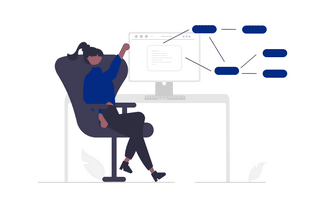
Roll With the Changes
On the whole, a law firm’s digital transformation means attorneys will have more time to focus on doing better, more creative and innovative work with the firm’s clients. That’s because tasks such as document drafting and review, legal research, eFiling, document retrieval, process serving, and more can be handed over to technology.
But digital transformation is never completely finished. It is an ongoing process that requires one eye to continually look for ways to improve the firm while maintaining buy-in from internal staff.
Advanced technology isn’t going away any time soon, so start planning your law firm’s digital transformation map today. You’ll discover that despite the challenges ahead you can get there from here.
Need help mapping out your law firm’s digital transformation?
Contact a Rapid Legal account executive to find out how our technology platform can power your future.
California Court Holiday Schedule 2022-2023

With a busy schedule, it is hard to keep track of when California courts are closed for certain holidays. Here at Rapid Legal, we are all about making your legal professional life easier – including holiday calendars. This resource is a snapshot of the court-observed holidays in California through 2023.
CALENDAR YEAR 2022
| Mon | July 4 | Independence Day |
| Mon | September 5 | Labor Day |
| Fri | September 23 | Native American Day |
| Fri | November 11 | Veterans Day |
| Thurs | November 24 | Thanksgiving Day |
| Fri | November 25 | Day After Thanksgiving |
| Mon | December 26 | Christmas Day* |
CALENDAR YEAR 2023
| Mon | January 2 | New Year’s Day |
| Mon | January 16 | Martin Luther King, Jr. |
| Mon | February 13 | Lincoln’s Birthday* |
| Mon | February 20 | Presidents Day |
| Fri | March 31 | Cesar Chavez Day |
| Mon | May 29 | Memorial Day |
| Mon | June 19 | Juneteenth |
| Tue | July 4 | Independence Day |
| Mon | September 4 | Labor Day |
| Fri | September 22 | Native American Day |
| Fri | November 10 | Veterans Day |
| Thurs | November 23 | Thanksgiving Day |
| Fri | November 24 | Day After Thanksgiving |
| Mon | December 25 | Christmas Day |
* If a holiday falls on a Saturday, the Court is closed the preceding Friday. If a holiday falls on a Sunday, the Court is closed the following Monday. (See CCP ” 133-136; Government Code” 6700 – 6701, California Rules of Court, Rule 1.11)
Process Serving: You Get What You Pay For

Outsourcing service of process to the lowest bidder can be irresistible for law firms looking to save a buck, but there are potential consequences associated with low-end pricing that can risk delays or scuttle a legal matter completely.
If you find yourself tempted to cut corners on service of process vendors, here are the best reasons to reconsider your decision before it turns one of your cases into a cautionary tale.
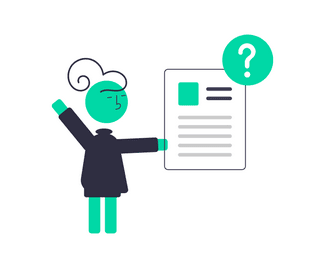
They don’t know the local rules
Nothing destroys a bargain like rookie mistakes or ignorance that costs you time and money. These mistakes range from substitute-service on an underage individual or non-occupant, to posting a 3-day notice without following up with a mailing copy or accepting an invitation from a witness to come into their home.
Sound bad? That’s just the beginning. Substituted service can also trip up process servers because the rules for substituted service aren’t always the “same” – “in” some instances they differ by jurisdiction. For example, an inexperienced or unskilled server may errantly perform a substituted service before local rules allow for it.
Likewise, inexperienced servers may not know that service is effected based on the laws and rules of the state from which the process originates. So, when serving New York documents in California, the process server better know the New York state rules.
Takeaway: Process serving laws differ from state to state. Before you consider a bargain process serve, make sure they have the expertise and experience to correctly serve court documents for you anywhere in the United States.
Where’s the sense of urgency?
One of the most important things a process server can do is comply with deadlines, so make sure the server you select isn’t asleep at the wheel.
A low-cost, inattentive process server may miss strict deadlines that apply to non-court filed documents (e.g. subpoenas) and court dated documents (e.g. applications and orders for appearance and examination).
If these documents aren’t served within a prescribed period of time prior to a hearing or deposition the witness or debtor may not comply; and the court would be loath to issue a bench warrant to make them do so.
Takeaway: Minimize the risk for fumbled deadlines by hiring an experienced process server who has in-depth knowledge of the applicable statutes for the particular document(s) they are serving.

Will they stick with the job?
Some process servers find it easier to throw in the towel than work diligently to make a successful serve as quickly as possible. If you’re wondering whether you’ll get champagne performance at Kool-Aid prices, ask yourself:
- Does the process server make attempts at the right time of day or night?
- Does the server “mix it up” and vary their attempt times if necessary?
- Will the server proactively ask neighbors and friends for clues?
- Does the process server pay attention to certain signals that may indicate when a subject is at an address but refusing to answer the door?
Some process servers may prematurely suggest a stake out instead of doing a bit more homework. That type of service destroys value and does nothing to elevate your own law firm.
Takeaway: There’s no substitute for commitment and competence; backed up by a satisfaction guarantee. Invest your process serving dollars in a vendor who is accountable and works in your best interest.
Where do good process servers come from?
The Ultimate Guide for Process Serving takes you inside the process server’s world and shows you which ones can be a law firm’s strategic partner.

What you should be getting
If you want to swim with the big fish, you’ll need real value from the process serving company.
What does real value look like?
When it comes to getting service of process that keeps your legal matter moving, real value looks like this:
- 80-90% serve success rate for documents that can be served.
- Flexible service levels that include:
- On-demand, immediate response.
- Next day.
- Standard. (Within 5 days of receiving a service of process order.)
- 2-3 day turnaround for a Proof of Service on a standard level of service.
- Up to 5-day turnaround for a Proof of Service on an out-of-state service of process.
Takeaway: Don’t compromise process serving effectiveness to save the price of a cup of coffee. A process server that operates with urgency pays for itself.

No more blind spots
It’s a big country and service of process for rural or hard-to-serve locations can be pricey. If you don’t know where you’re spending the most money for service of process, then you may have a blind spot that is draining valuable revenue from your law firm.
Your vendor can help you eliminate blind spots by providing reports that show:
- Service of process orders by pricing zone
- Orders by type
- Service level distribution
- Service of process performance
Find out more about what these reports reveal and how they can help protect your law firm’s bottom line in Technology Your Process Server Should Be Using.
Takeaway: Detailed business intelligence that improves your bottom line may not be something the lowest bidder can provide. Get a process serving company that has the technology, real-life experience, and statutory knowledge to give you the best insights and performance nationwide.
The one right tool for the job
Do you bounce between a laundry list of low-budget vendors each day to manage your litigation support services?
Instead of juggling a variety of dashboards to access a handful of bargain-priced providers, get a vendor whose technology provides a single online portal for you to create, modify, and monitor multiple orders in one session.
By directing your orders from one point you’ll save time and money on services such as:
- Service of process
- eFiling
- Physical filing
- Expert document review
- Courtesy copies
- Document retrieval
- Secretary of state filings
- Skip tracing
- and more
Takeaway: Your law firm doesn’t pay for just of one kind of service. Look at how well the vendor serves the overall needs of your law firm to gauge whether you’re getting what you pay for.

Third-party confirmation and referrals
If you’ve ever purchased a Louis Vuitton bag at a swap meet only to watch it disintegrate as you walk to the parking lot, then you know the value of trust. And you know why people are willing to pay for trust.
Worrying about every order you place kills productivity. So, if you’re uncertain about whether you can trust a warehouse-priced process server, here are four signs to look for:
- A guarantee
- A track record
- Testimonials
- Transparent pricing
Price transparency is particularly important. Be sure you get a reliable estimate up front about how many days are needed to complete the serve and receive the Proof of Service.
Takeaway: Find a process serving company that offers a price and deadline calculator.

When customer service couldn’t care less
Dirt-cheap pricing won’t seem like such a deal when an order goes sideways and no one “cares” — “except” you. That’s why personalized assistance is invaluable when you’re in a tough spot. It’s also critical to get support in the way that best fits your work style: chat, phone support, or email.
Takeaway: If the big firms consider world-class customer service a good investment, maybe you should, too.
Want the Ultimate in Customer Support?
Rapid Legal’s Concierge Service has you covered with expert document specialists who review your documents and place your order for you.
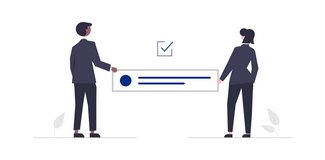
Let’s make a deal
Everyone wants a bargain but paying rock bottom prices for services that don’t provide value may be no bargain at all. Especially if those discounted services make your job more difficult instead of easier.
If you’re still grappling with whether your economy-fare process server is providing a good return for your dollar, ask yourself four simple questions:
- Is their service good?
- Is it convenient?
- Is it done right?
- If it’s done wrong, how do they make it right?
Service of process is not a commodity. It requires vendor personnel who have agile minds and persistence as well as technology that provides communication and accountability. Invest your spend on a vendor who will do it right, be there for you in a crunch, and whose performance raises your own.
Because excellence is never on sale, and you always get what you pay for.
[Updated] The Complete Beginners Guide to eFiling in 2022 and Beyond

NOTE: This page was updated on May 23, 2022.
For nearly a decade, a major change has been driving through the California court system transforming litigation support services for the better: the transition to civil eFiling. But that change didn’t hit the tipping point until one of the largest court systems in the world, Los Angeles Superior Court, started migrating to eFiling in December 2018.
For the legal professional who needs to keep up with the new eFiling changes or wants to ramp up their eFiling savviness, this step-by-step guide teaches everything you need to know for eFiling in 2022 and beyond.
Table of Contents
- What is eFiling?
- Why eFiling Affects You
- Now What? How to Shop for an eFiling Service Provider (EFSP)
- Are Multiple Vendors Better Than One?
- Know the Rules Before You eFile
- What if my eFiling is Rejected?
- Who’s Who in eFiling
- Measure Your eFiling Efforts
- Prepare to Launch
Are you an eFiling novice?
Get your Beginner’s Guide to eFiling now!
Download your free copy.
What is eFiling?
Let’s begin the eFiling journey by understanding what eFiling is, and how the courts define the role of an electronic filing service provider (EFSP).
The 2022 California Rules of the Court, Rule 2.253, defines eFiling this way:
“The electronic transmission to a court of a document in electronic form.”
And, this is how the court rules define, “electronic filing service provider”:
“An ‘electronic filing service provider’ is a person or entity that receives an electronic filing from a party or other person for retransmission to the court or for electronic service on other parties or other persons, or both. In submission of filings, the electronic filing service provider does so on behalf of the electronic filer and not as an agent of the court.”
The electronic filing service provider (EFSP) submits filings on behalf of the electronic filer. The EFSP is not acting as an agent of the court.
When a court decides to accept electronic filing, it may implement it in different ways. Sometimes a court initially begins with permissive eFiling, and later makes it mandatory, or vice versa. Other courts can start with permissive or mandatory for certain case types and then add other case types later as voluntary or involuntary.
If you’re unsure about the differences between mandatory and permissive as they apply to electronic filing, here is how the California court defines each type.
Permissive electronic filing by local rule
“A court may permit parties by local rule to file documents electronically in any types of cases, subject to the conditions in Code of Civil Procedure section 1010.6, Penal Code section 690.5, and the rules in this chapter.” (From 2022 California Rules of Court, Rule 2.253.)
Mandatory electronic filing by local rule
“A court may require parties by local rule to electronically file documents in civil actions directly with the court, or directly with the court and through one or more approved electronic filing service providers, or through more than one approved electronic filing service provider…” (Complete conditions and rules for mandatory eFililng appear under Rule 2.253 of the 2022 California Rules of Court.)
Don’t let the e’s confuse you
It’s an E, E, E, E world out there, thanks to a workplace saturated with technology. That is not a problem for the most part, since technology is the rainmaker of efficiency.
However, technology can muddy the terminology that is used for electronic filing. One of the biggest perpetrators of this confusion is the letter “e”, which is popularly used as a prefix for invented words.
There are at least three “e”-prefixed words in the electronic file and serve lexicon that, at first glance, may seem related. In fact, they refer to very different processes used by various courts and cannot be used interchangeably.
Here are three terms you should learn to distinguish before you move to an eFiling workflow.
| “e” Term | What it means |
| eFiling | The electronic transmission to a court of a document in electronic form. |
| eService | A method of electronically notifying parties about a document that has been filed or submitted. eService allows all the documents that need to move back and forth between the parties or their counsel to flow electronically. |
| eDelivery/eSubmit | A platform – or web portal – that allows parties to submit electronic (PDF) versions of documents in place of the original directly to individual courts. eDelivery is not fully integrated or automated, and requires a court clerk to manually input into court case management system |
If you want even more clarification about these terms, a chart in the article Did You Know? eFiling vs. eDelivery and eSubmit Are NOT the Same! explains the differences in depth. You can also use the chart as a reference to see at-a-glance which California courts offer eFiling, eDelivery/eSubmit and physical filing.
Why eFiling Affects You
Since eFiling began in California courts during the early 2000s, it has charted a steady path upward. This one-way growth suggests that sooner or later, eFiling will become the law of the land.
If that seems dubious, consider a few statistics:
There are 58 trial courts in California; one for each county. As of summer 2023, eFiling became mandatory or permissive in 36 California Superior Courts, making it part of the workflow for law firms in more than 62% of the state’s counties. Electronic filing is accepted in areas with the largest concentrations of people and businesses in the Golden State, including Los Angeles Superior Court, which is the largest trial court in the United States.
Outside of Los Angeles, cases are filed electronically in Superior Courts in San Francisco, San Diego, Riverside, and Orange County, plus many more.
Based on the current numbers, it could be said there are two types of law firms in California: Those that currently use eFiling, and those that soon will be.
Now What? How to Shop for an eFiling Service Provider (EFSP)
Don’t wait until the first day eFiling is required to find an EFSP. This is especially true for firms that are new to electronic filing. An experienced and qualified EFSP can act as your wing man through the startup process and help you avoid mistakes and delays that are common among first-time eFilers.
How do you recognize this vendor? There are five categories you should consider as you conduct vendor interviews:
- Scope of service
- Performance and productivity
- Domain knowledge and expertise
- Performance metrics
- References
Here is how to use each category to guide your discussions:
Scope of service: The first thing to look for is a vendor that files into all the California courts that have eFiling available. That means all of them. Not a few, not some, not even most. You need a vendor that files with 100% of the California courts that accept eFiling. That way, you and your team don’t have to manage several vendors and systems to eFile into courts. (Those courts are listed here.)
You’ll also want to know whether the vendor you’re interviewing offers other critical litigation support services and has a well-documented performance and acceptance rate with the courts.
Performance and productivity: Does the vendor offer eFiling through a portal, application programming interface (API) or both? The right partner should offer both because that gives it the greatest extensibility and flexibility to integrate with other computer applications like practice management systems and more.
Your vendor should also tell you whether court-stamped documents are returned quickly and reliably, and whether it makes custom reports and analytics available.
Domain knowledge and court filing expertise: Any vendor can say they have experience. That’s an easy claim. What you need to know from a vendor that wants to be your preferred provider, though, is the level of experience that vendor has with eFiling and/or physical filing throughout the California court system.
You’ll also want to ask about customer support options and additional litigation support services the vendor offers.
How are you able to reach the vendor? Via phone? Email? Chat? All three? The ideal partner will offer multiple means of communication to reach them. And keep in mind, a vendor that doesn’t have a portal that provides a single point of access to all courts and multiple court services is probably not a vendor that will serve you well.
Performance metrics: What turnaround times are offered by each prospective vendor partner? This is important information to understand because it will give you an idea about how efficiently and effectively the vendor can execute its services for you. Likewise, before you make a decision, each vendor should provide its eFilling success rates, user behavior, and order data.
References: Track records matter. Reputation matters. What courts say about an EFSP certainly matters. As you interview potential vendors, be sure to ask them for court and customer references to contact.
Free Download: Access the EFSP Checklist Now
Are Multiple Vendors Better Than One?
What happens if you find more than one vendor that you like? Or, does it make better business sense to work with a single, preferred EFSP or multiple EFSPs?
You’re not the first law firm to face this dilemma.
Traditional supply chain wisdom has favored the multiple vendor model for its redundancy and backup. Those reasons were not unsound in the 20th century, but this is the 21st century and the product in question is not a widget or commodity.
Single, Preferred Vendor Advantages
Pricing Discounts: From a strategic standpoint, amplifying spend not only places you in a stronger position to ask for volume discounts, but it also makes it more likely you’ll receive additional perks such as hands-on, personalized customer care, or first access to new technologies.
But why restrict pricing discounts to eFiling only? If the volume of your work is spread among several different services, you expand the number of services on which you may receive pricing discounts, such as process service, document retrieval, courtesy copy delivery, county recording, and more
More Time for Billable Tasks: Billable hours are the lifeblood of any law firm and every minute that staff members spend on overhead tasks drives up the cost of doing business. Over time, a law firm may lose significant amounts of billable hours to activities associated with the multiple vendor model.
What cuts into billable hours?
|
It’s also a fact that when support staff train on only one vendor’s system and repeat those tasks many times, each staff member becomes more efficient, creating greater bandwidth for billable tasks.
Visualize Better Performance through Partnership: When you choose to work with a vendor who sees you as a true partner, you unlock the potential for system-to-system integrations that will save you even more time and money.
How much more? The answer depends on your needs and creativity, but here is an example: You make reconciling invoices and expenses for fee motions so efficient that it saves the cost of one full-time employee. Find out more about this benefit in How Law Firms Can Get Better eFiling Pricing and Service with a Single, Preferred Vendor.
Know the Rules Before You eFile
Every California county’s court eFiling rules are different, and those who eFile without knowing those rules does so at their peril.
To vastly improve your eFiling’s chances of success, simply check your county’s rules. Other resources and useful court links can be found here.
If you don’t know the rules, there is a good chance your eFiling may be rejected by the court. In this next section, find out how to reduce the likelihood that your future eFilings will be rejected, and what you can do if it happens to you.
Learn the Rules
There is no “grey area” when it comes to electronic filing in California civil court. Make your eFiling rejection-resistant before you submit your first order by reading, Strict eFiling Requirements Enforcement and What it Means for You.
What if My eFiling is Rejected?
You’ve been rejected. It’s not the end of the world, but it may be the end of your relationship with your client.
About 1 in 10 electronic filings can be rejected by the court. When eFilings are rejected, they may cause a statutory deadline to be missed or jeopardize a case in another way, creating an unfortunate domino effect that ends with your client finding another law firm.
Here are the common reasons a court may reject an eFiling:
- Party’s name does not match the name listed on the initial lead document
- Incorrect case type has been selected
- Incorrect document type has been selected
- Wrong case number has been listed somewhere on the filing
- Wrong court location has been selected
Issues with the filing itself, like uploading the wrong filing, submitting the filing in the wrong format, having the wrong name on the saved filing, improper scanning, or not including the required attachments.
So, it’s probably not surprising that eFiling rejection rates hover between 10-15%, depending on the court. That equates to 1 – 1.5 out of 10 court eFilings being rejected! What can be done?
To minimize eFiling rejections, Rapid Legal created two solutions – Expert Review and Concierge Service. Both can help assure greater success across your eFiling initiative and may be especially useful for very complex cases or cases for your clients who demand the highest level of accuracy.
Where electronic filing is concerned, the best way to manage rejections is to prevent them from ever happening. That may sound like a tall ask, but it’s easier than you may think.
How to avoid a court filing rejection at the court:
Triple-check everything.
It’s always a good habit to double-check your work. Is that enough? Usually yes, but when it comes to court documents, you should always take the time to give them one last review before sending them to be filed. That last review can be crucial in catching a wrongly dated form or a missing signature, even an out-of-date Proof of Service. When you’ve finished filling in a form or titling a document, check it. When it looks good, check it again. Before sending it, check it one more time. Your client, your case or your reputation could depend on it.
Sign and date everything.
This might sound self-explanatory, but a missing signature is a surefire way to have your documents rejected by the court. Even if the window clerk misses it, you can bet the clerk of the department won’t. This is a very common pitfall for court rejections. Consider yourself warned (wink).
Be understanding of the clerks.
The clerks hold the ultimate power. They can decide whether to file your documents simply based on the kind of day they’re having. Okay, not all clerks are mean or spiteful, but like everyone, they don’t like to do extra work for a bunch of random individuals bugging them while they attempt to get their work done. Do you? Every time you must ask a clerk in the department to schedule a hearing date, approve a date or to argue a rejection, that’s extra work for them and they hate it. So always treat them with respect and be courteous – hello, have a nice day, thank you – it all goes a long way.
Know what you’re filing.
Not every document should be treated the same. A Request for Dismissal may be okay to leave at the window, but a Stipulation and Order might need to go to a specific department. These documents might be similar, but they are not the same. Know where they go. You don’t want to waste your time or the clerk’s time by getting in the wrong line or having your documents sent to the wrong place.
Know the local rules.
Many documents may look the same with very similar sounding titles but that doesn’t mean they are treated the same. Said another way, not all documents are created equal. There may be a specific document that requires having a hearing set by the department clerk before filing or a fee that needs to be paid before being received and filed later. Some courts may require a specific cover page to be filed with all new cases. If you aren’t sure about what’s required, court websites have plenty of information regarding filings. Also, if you need a specific form, they usually have them available on their website or they’re just a simple Google search away.
Avoid PDF Peril Don’t make the rookie mistake of submitting electronic documents in the wrong format. This is particularly important for Portable Document Format (PDF) files. Before you eFile, check the local court’s rules about saving Portable Document Format (PDF) docs in a text-searchable format. Also, find out if you need to create your PDFs with a specific application such as Adobe Acrobat Version 7 (or higher). You’ll increase your chances of eFiling success and reduce the likelihood of missing a time-sensitive court deadline. |
Who’s Who in eFiling
There are many key stakeholders that are involved in the submission, transmission and completion of California court eFilings. As a certified Electronic Filing Service Provider (EFSP) for 30 California courts and counting, we examine the main stakeholders of the California Court eFiling system. Who are the players? What are their roles? And why are they important?
Key Stakeholder 1: The eFiling User
An eFiling user is a user of the eFile case’s Electronic Filing Service Provider (EFSP) and typically places an order and/or submits the case. This person may be the case initiator or the point of contact throughout the life of the case. There could be many eFiling Users for one case. Examples of an eFiling user include Paralegal, Office administrator, Attorney, Secretary, Pro-pers, EFSP Operations user, EFSP customer, court runner, field agent, and more.
Stakeholder 2: Case Participants
A case will consist of case participants which are people, businesses, or organizations involved in the case. This usually consists of a plaintiff (a person who brings a case against another in a court of law) and a defendant (in a civil suit, the person complained against; in a criminal case the person accused of the crime).
Stakeholder 3: Electronic Filing Service Provider (EFSP)
As mentioned above, an eFiling user places an order via an Electronic Filing Service Provider (EFSP), which is a company whose online portal has been certified to transmit documents to a court via an integration with an Electronic Filing Manager (EFM), such as Tyler or Journal Technologies (JTI). In addition to providing eFiling services, an EFSP also typically provides value-added services, training, and support to eFiling users.
As a certified Electronic Filing Service Provider (EFSP) for more than 20 courts, Rapid Legal’s technology is integrated with various court Electronic Filing Managers (EFM). These integrations enable filers to electronically file documents directly with the Court through Rapid Legal’s portal.
Credibility by the Numbers
Nothing speaks to an EFSP’s experience and performance like numbers. These data points explain why Rapid Legal has a reputation for excellence among legal professionals.
| 1,000,000 More than 1 Million Orders Placed | 2,000,000 More than 2 Million Documents Processed | 10,000 More than 10,000 Customers Served Nationwide |
Stakeholder 4: Technology Provider of Electronic Filing Manager (EFM) Software
Next, the Electronic Filing Manager (EFM) acts as an intermediate system on the Court’s side. This is the system that receives the filings and processes them for the court clerks to view and manage. The EFM connects to the court’s Case Management System (CMS). All courts must use an EFM to manage their backend system.
Click here to view our handy guide that outlines which Court uses which EFM, whether it is mandatory or permissive, case types for eFiling, and associated costs.
Stakeholder 5: The Court and Case Management System (CMS)
Lastly, the stage following the EFM is the Court’s Case Management System (CMS). This is the Court’s backend system that automates court processes, monitors case activities, and supports decision-making through the use of real-time data and analytics. A case management system consolidates and maintains all the information that is pertinent to a case. Users of the court’s CMS include personnel such as clerks, judicial officers, and judges.
Measure Your eFiling Efforts
Use data to set benchmarks and know whether your new eFiling workflow is performing up to its potential. This is where it pays to become a Rapid Legal power user because you can integrate your law firm’s systems with Rapid Legal’s system to transfer data and see what’s working, what isn’t, and where to optimize.
Sharable data can also be used to create strategic business reports. These reports provide detailed views of orders placed through the portal. At a glance, users can see which types of orders contribute positively to the firm’s bottom line and which types compromise it.
This data allows you to course-correct by setting up cost control measures if needed. Likewise, you can use them to monitor throughput, detect trends, and analyze your firm’s and the vendor’s performance.
Two important measures you can make are Service Level Distribution and Orders by Type.
Service level distribution helps you determine whether you are paying for the most expensive level of service when the least expensive service meets your needs? Use this data to analyze the service you’re buying and make sure it’s the service you need.
Orders by type takes the guesswork out of locating where the greatest volume of your work lies. Is it eFiling, service of process, or something else? Review the data and then decide whether to adjust.
Learn more about how to use sharable data in this technology-focused article on the Rapid Legal blog.
Prepare to Launch
Now that you have a clear view of the eFiling landscape, you’re in an excellent position to manage the launch of your own law firm’s eFiling initiative. By reading this article you’ve learned how to interview a vendor, overcome rejection, and measure the success of your efforts. The next step is to contact a qualified EFSP and find out how they can help set up your office’s eFiling workflow.
Take that step now by contacting Rapid Legal. We file electronically into the most courts in California and operate on a technology platform that sets the standard for speed and reliability in the industry.
That’s not just talk. Rapid Legal guarantees your satisfaction: If service is not done right, it’s free.
Book a demo or schedule a call with a team member. Get a close-up view of the Rapid Legal portal and how to set up eFiling in your office’s workflow.
9 Questions to Ask a Process Serving Company

Finding the right process serving vendor can be the legal professional’s version of an Easter egg hunt; and not in a fun way. Sure, you could look for clues on Twitter or plumb the depths of Reddit but sifting through the social media haystack for hours on end probably isn’t a good use of your time.
To keep you from falling into the vendor interview sinkhole we’ve created this nine-question probe to get the clear and direct answers you need to qualify a process serving company.

Question 1. How much experience do you have?
The answer to this question should reveal much more than how long the company has been in business. It should help you determine whether a provider keeps up with legal technology, stays atop court rules, and keeps pace with the evolving legal industry.
You’re looking for clues about how the company has developed expertise and industry insight during its years of operation. A vendor that possesses expertise and insight will demonstrate that it understands:
- What clients look for in each situation regarding the type of document being served and the timeliness with which the document must be served.
Among these documents, also referred to as dated documents, are subpoenas, orders, or motions. Any document for which a hearing date is applicable.
As an example, subpoenas must be served in what the court deems as “reasonable time to appear”. Other documents, such as orders, have a statutory deadline for when the document must be served prior to a hearing date.
- The relationship between the documents being served and the deadlines those documents must follow.
- Variations in court requirements for diligence.
- How different courts feel about certain types of services. This may include refusal of service (process server places documents near the party being served) or substituted service of process (process server gives documents to an agent of the defendant, another adult in the recipient’s home, or a corporate office).

Question 2. What is your serve success rate?
Determining a process serving company’s serve success rate should be straightforward, however, there is a glut of statistics associated with process serving that can muddy the waters for this metric.
To get a clear view of serve success, let your prospective vendor know that you want to focus on the total number of documents that can be served.
What does that mean, exactly?
Documents that can be served have a valid address for the individual to be served. Likewise, for documents that can be served, the process server has a high degree of certainty about when the person will be at the address to accept papers.
The success rate of documents that can be served should be in the range of 80-90%.
An important distinction
As you interview vendors be aware that there is an important difference between documents that can be served and documents to be served.
Documents to be served refers to the total number of documents ordered for service of process. This includes service of process orders that are challenging to serve due to factors such as bad addresses and evasive parties. These influences can drive down the company’s overall success rate and make the process serving company appear less effective than it actually is.
Losing Money on Your Service of Process Expense?Your process serving company should be doing more for you than simply checking the boxes when a serve is complete. It should provide business intelligence that tells you which aspects of your service of process orders are performing well and which may be losing money for your firm. You can use these reports to monitor performance and prevent overpayment by checking the:
Learn more about how data from your vendor can help you better control your law firm’s spend. Read Technology Your Process Server Should Be Using. |

Question 3. What are your deadlines?
Your process server should be crystal clear about document cutoff times so you can make sure the papers are served in compliance with court rules.
There are two types of deadlines your prospective process serving company should be prepared to discuss with you:
- Non-Court Dated Documents
These documents are provided at a certain time of day so the server can make the initial attempt to serve. Deadlines will vary depending on whether documents are to be delivered to a business address or a residential address.
- Court Dated Documents
Documents such as a subpoena or a court order to show cause have specific deadlines for when they must be served. Therefore, it’s crucial for a server to know the state and local rules governing deadlines.
The process serving company should make sure the papers are served sufficiently in advance of a hearing or deposition to give the other party enough time to appear. If documents are not served sufficiently in advance a judge may throw out a case based on insufficient process.
Question 4. What are your service levels?
Law firms do not operate in a one-size-fits-all world. Therefore, services that are flexible and scalable should be the standard for the process serving company you choose.
In some cases documents will need to be served as quickly as possible, so an on-demand or same-day service should be available as a standard option. Putting all your work in an on-demand bucket, however, will likely result in overpayment for urgency you don’t need.
That’s why you should search for a company that offers a diverse level of services. The right one will align with your timing needs and budget.
While the service levels of process serving firms are similar, there are differences. For example, Rapid Legal’s four service levels are:
1. On demand: A five-alarm, all hands-on deck response. Work begins on the order immediately and focuses on making the first attempt to serve within 2 hours of receiving the document. Keep in mind that if you have a service of process that must be performed in a remote locale or rural area, that may extend the serve time to 3 or 4 hours.
2. Urgent: Service of process is attempted same day or same evening. The time of day the serve is attempted is scheduled according to where the papers are being served. Daytime work hours for business address and evening hours for residential addresses.
3. Priority: Service is made the following day. If the first attempt is unsuccessful then subsequent attempts are made every couple of days thereafter.
4. Standard: Service is attempted within 3 to 5 days of receiving the service of process order.
Bottom-line: You will want to select a vendor that provides enough flexibility to match the urgency you need with a price that makes sense.
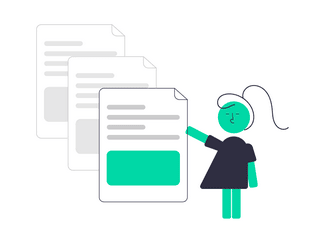
Question 5. When can I expect to receive my Proof of Service?
Everyone likes security, and that’s what a Proof of Service provides. The company you interview should be able to provide that security in the form of a physical document signed by the process server that states when the document was served.
Turnaround on that document should be as quick as possible. Here are two benchmarks your process serving company should meet:
- Turnaround for a Proof of Service with a standard level of service ordered should be 2-3 days.
- Turnaround for an out-of-state service of process may extend to 5 days.
Remember, many process serving companies use a computerized system to create the proof of service document. That document requires the physical process server to review and apply or attach a signature to the proof of service. This may delay turnaround in varying degrees.
Wouldn’t It Be Nice?Just imagine: You place a service of process order from your computer anytime, anywhere; then email updates about the order begin to appear. The updates continue until service is effected and your Proof of Service arrives in your email inbox. That’s not a dream. That’s the Rapid Legal standard for service of process. And the service can be provided for parties or registered agents located anywhere in the U.S. You can get this convenience on common documents Rapid Legal serves such as:
Contact us now to learn more about Rapid Legal’s superior service of process. And with Rapid Legal, service is free, if it isn’t done right. That’s our guarantee. |
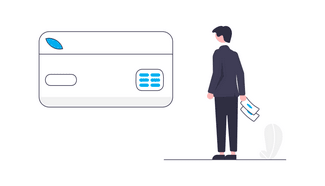
Question 6. What are your charges?
This question is never really about money. It’s about value.
As you look for value in the price you pay, here are two important features a process serving company can offer that will add value to your spend:
- A system that monitors your serve anytime you want to look at it. You can see attempts and you can see the progress of the serve.
- A dedicated operator in the office that manages your serve and can update, provide direction, and communicate with the server.
While you weigh the question of value, keep in mind that two factors have an important influence on the cost of service of process:
- Speed with which the document must be served.
- Location of the party to be served (i.e., rural or metropolitan).
Always pay attention to the fine print, too. A good vendor provides transparent pricing without hidden fees. The best vendors will have an online pricing calculator so you can know the complete cost of your service of process up front.
Remember that the fee any process serving company charges should seal confidence and assure that your service of process order doesn’t become a slow-moving crisis.
Interview Like a GuruCommand your interviews with prospective process serving companies by deepening your knowledge about service of process. Read The Ultimate Guide for Process Serving. Want to become the office expert? Get bonus tips and insights in What to Look for When Hiring a Process Serving Company about these key areas:
|

Question 7. How do you handle evasive parties?
Nothing slows down service of process like an evasive party. Multiple service attempts cost time and money, so it’s good to know up front whether your service of process vendor is well-equipped to deal with these orders.
The process serving company should use clues from each attempt to construct a window of time when the person to be served most likely will be present. To do this, the process server’s in-person tactics should include:
- Checking with the neighbors.
- Taking note of movements, vehicles, blinds open or closed, trash cans placed on the curb.
- Checking whether a name appears on a gas meter.
- Observing the property.
- Verifying the property is where the defendant resides.
- Performing a stakeout.
If multiple attempts fail it may be necessary to perform a stakeout. Your vendor should be able to handle this important task or offer a concierge service to help escalate your response to evasive parties as needed.
Concierge service can provide expert assistance for service of process, electronic court filing, document review, and more.
Struggling to serve an evasive party?
Rapid Legal offers skip tracing to locate an individual’s whereabouts.
Contact us for a quote.
Manage Cases
Process serving companies should have powerful online technology to help address difficult serves. For example, some providers offer a manage cases feature that allows the process server to enter information about the attempt into a record the law firm can access.
Law firms log into the manage case feature to check on the order’s progress and see information about the attempt.
The server may include information such as whether the door was answered, lights in the home were on or off, whether cars were parked at the residence, automobile license plate numbers, etc.
Plan B: Substituted Service of Process
If personal service on an evasive party cannot be completed after multiple attempts, a process server may perform substituted service of process on another person or entity. This is also known as a sub serve.
The types of parties that may be used for a sub serve vary, so it’s critical for the service of process company to be well acquainted with the local court rules governing sub serves.
The California Civil Code varies by county with regard to due diligence required before a sub serve is permitted. Likewise, some courts may require personal service be attempted at particular times of day before a sub serve is permitted. The process server’s understanding is critical in these cases to make the serve efficient and in compliance.

Question 8. Tell me what sets you apart from other process servers or companies?
A crowded list of prospective vendors can thin out quickly when you filter for competitive characteristics. But how to recognize a meaningful differentiator when so much of the industry is lacquered by sameness?
Look for a company that thinks different. Instead of tired old mantras such as “Great quality and service,” look for a vendor that emphasizes communication and being purpose-driven.
In the context of a process serving company, here is what those two qualities should describe:
1. Communication-driven
The way a process serving company communicates doesn’t need to be complex, it simply needs to be clear. More importantly, communication needs to actually take place. A good service of process company understands that and communicates with a law firm honestly and frequently. It also makes communication accessible via telephone, email, or chat.
2. Purpose-driven
Every document matters to someone regardless of whether it’s a company or person, husband or wife, landlord or tenant. As you narrow your search, look for a vendor that believes in the gravity of the work it does. A top-performing service of process company is one that knows it’s not just the law firm that is trying to get the document served, but also the case participant.

Question 9. What do your customers say?
Asking a vendor for references, testimonials, or case studies doesn’t have to be an awkward game of Truth or Dare. Simply ask for references from the vendor’s customers and let them know you want to open dialogue with other legal professionals.
This is an opportunity to compare your needs and experiences with peers who can tell you how the firm performed for them in similar situations. The right answer should be affirming and enthusiastic. Something like this:
“We absolutely have a list of customers for whom we’ve done work for a long time who value our communication, honesty, reports, analytics, and desire to get the job done. We’re happy to give you a list whenever you need them.”
See what legal professionals have to say about Rapid Legal.
Check out the customer testimonials at www.rapidlegal.com

It’s Time for Better Value and Reliability
You may not understand every nuance of service of process but you understand your law firm’s supply chain. You also understand your responsibility to get the best value from your vendors. Ask these nine questions up front and you’ll avoid hidden costs, gain confidence, and launch a strategic partnership that will add value to your law firm now and in the future.
Share your service of process challenges with an account executive now and explain what you need to succeed. Call now or Book a demo to get started.
Simple Meditations for the Busy Legal Professional

Meditation isn’t something that only happens on the mountaintop, and mindfulness practice doesn’t just exist at the yoga studio.
Mindful meditations can refocus you, re-energize you, and help you to be more successful and productive. Which is why they should become an important part of your daily work routine. Taking a moment for yourself, shutting out the background noise of life, and clearing your thoughts can make a dramatic difference in your ability to handle all the stress that comes from today’s hectic law office environment.
The exercises presented here will help you reduce stress and improve focus by sharpening your cognitive abilities and keeping your mind in tip-top shape. They will help you hone traits such as focus, creativity, empathy, and listening, all of which can make legal professionals better at what they do.
These mindful meditations are designed to be used anywhere and at any time. All it takes is a little focus on your part. We suggest sprinkling these exercises throughout your workday, spending a few minutes on them every hour or so.
And if you’re worried about finding the time, well… as Dr. Sukhraj S. Dhillon says in The Art of Stress-Free Living, “You should sit in meditation for twenty minutes every day – unless you’re too busy; then you should sit for an hour.”

Exercises
1. Mindful Breathing Countdown
A mindful approach to breathing forms the basis of many more complex types of meditation, but it can also be a powerful tool on its own. This is a great thing to do at the end of your morning commute, on the elevator in your office building, or any time you need to refocus at your desk.
- How Long it Takes
- At least 1 minute.
- How To Do It
- Let your eyelids grow heavy or close your eyes completely.
- Take a slow, deep breath in through your nose, then exhale slowly through your mouth.
- Focus on the sensation of the air moving past your nostrils and lips, and on the sounds of your breath.
- Repeat this breathing cycle for at least one minute (you may want to set a timer to help with this).
- What’s the Benefit?
- Focusing on your breathing will help alleviate stress, center your attention, and bring about a sense of control.
- Why it Works
- Deep, controlled breathing has been shown to lower cortisol levels, resulting in lower levels of stress.

2. Body Scan
Body scan is another basic approach to mindful awareness. Anyone who has taken a yoga class has probably done some variation of the body scan at some point. It’s a great way to refocus your mind and recharge your ability to concentrate.
- How Long it Takes
- 3 to 10 minutes.
- How To Do It
- Sit or lie down in a quiet space, such as an empty conference room or a nearby park. Close your eyes if you’d like.
- Focus your attention at the very top of your head, then slowly bring your attention down to your forehead, through your jaw, and on past your neck.
- Try to relax each part of the body you’re focused on. If your thoughts wander, simply acknowledge it and return focus to yourself.
- Practice slow, controlled breaths as you continue to scan your attention down your whole body, all the way to your toes.
- What’s the Benefit?
- Taking a few minutes in a quiet space will re-energize you and help you find a new sense of focus.
- Why it Works
- Slow, deep breathing in a quiet environment will lower your stress levels and leave you feeling recharged.

3. Mindful Stretching
Not only does a mindful stretch bring your mind’s attention back to what matters, it helps alleviate the kinks and cramps that come from office life. Whether you want a more subtle stretch or seek to re-energize yourself with something a little more active, taking a few moments to loosen the body and clear the mind will help make your days more productive.
- How Long it Takes
- 20 seconds to a few minutes.
- How To Do It
- Sit upright in your chair and extend your arms straight up above you, palms facing forward.
- Breathe deeply and slowly in through your nose. Try to fill your lower belly with air before letting your chest expand. Exhale slowly through your mouth. Focus your attention on your breathing and let other thoughts of the day slip away.
- Continue to breathe slowly and deeply. As you inhale, try pushing your fingers even farther into the air. As you exhale, feel the muscles in your arms and shoulders relax.
- To make the stretch more active, reach each hand up as though you’re picking apples from a tree, alternating from side to side as you breathe.
- After a few rounds of breath, lower your arms and shake them loose. Repeat the stretch as many times as you’d like.
- Search for other stretches you can do at your desk and apply the same focused breathing techniques above to transform them into mindful stretches!
- What’s the Benefit?
- Mindful stretching will help clear your mind and release areas of tension in your body.
- Why it Works
- Stretching helps to reduce fatigue, realign your posture, and prevent pain.

4. Calming Visualization
Creating a visual in your mind is an effective meditation technique. If all you knew about meditation before reading this article came from the movies, this is probably what you were expecting to read about. “Picture yourself standing on the banks of a cool, clean mountain lake,” for example. But visualization is a useful form of meditation that can have a very calming effect.
- How Long it Takes
- 1 minute.
- How To Do It
- Close your eyes and picture your favorite outdoor space. Maybe it’s a waterfall at the end of a long hike, or a tree you used to climb as a kid.
- As you breathe deeply, try to picture more and more details of the place in your mind. Focus on colors, shapes, and movements.
- Try to recall the way things smelled, the way they sounded, and the way they felt. Were you in the warm sunshine or in a cool lake? Do all you can to put yourself back in that moment, at that place.
- Continue to breathe as you pull yourself out of the visualization, tucking it away to return to again later.
- What’s the Benefit?
- Give yourself an escape from stress by visiting a calming memory from the past.
- Why it Works
- The combination of relaxed breathing and powerful visualization helps reduce stress and reset your mind.

5. Object Meditation
Stop and smell the roses… Literally. Object meditation is the mindful observation of another thing. It’s particularly effective with objects from nature, which make it a great excuse to brighten up your workplace with some freshly cut flowers.
- How Long it Takes
- At least 1 minute.
- How To Do It
- Focus your attention on an object at your desk. Choose something natural, such as a flower or a seashell.
- Slow your breathing, and let your mind come to rest fully upon the object you’re studying.
- As you continue to breathe, try not to notice anything else around you except for your focus object. If your thoughts start to wander, simply redirect them back onto the object.
- Let your eyes explore every aspect of the object, as though you are seeing it for the first time. Think about where it came from, and how it fits into the greater context of your surroundings.
- What’s the Benefit?
- A meditative object makes it easier for your mind to focus, allowing you to reduce stress and collect your thoughts.
- Why it Works
- Keeping this object in your office space creates a gentle reminder to remain focused and energized.

6. The Water Meditation
There’s a different benefit to the water cooler besides having a place to talk about the latest happenings or whatever Netflix series your office is currently addicted to. The human body is mostly water, and a mindful approach to drinking can be a powerful exercise in connection.
- How Long it Takes
- 30 seconds to a minute
- How To Do It
- Pour yourself a glass of water. Pay attention to the way it takes shape in the glass. Notice its movement. Take note of any tiny air bubbles or droplets within the glass.
- Take a sip of the water and hold it in your mouth. Note its flavor. Feel how its temperature contrasts with that of your body.
- Gently swallow and feel the water entering your body. Try to track it all the way down your throat into your stomach.
- What’s the Benefit?
- The simple act of drinking water can become a powerful calming experience.
- Why it Works
- Hydration helps the brain function more effectively and transforming a habitual act into a mindful experience is one of the key tenets of mindful meditation.

7. Walking Meditation
You may already get up and go for a walk around the office when things get stressful. That can easily become an act of meditation! You get the whole body moving, which can have an important impact. Add a component of mindfulness by being conscious of what you observe as you walk.
- How Long it Takes
- 5 minutes or more
- How To Do It
- Get up and take a walk. You can have a destination in mind, or you can simply pick a direction and wander.
- As you walk, focus on taking in the sights and sounds of the world around you. If something catches your attention, give yourself permission to stop and examine it a while.
- Breathe slowly and deeply while you walk. Try to clear the thoughts from your mind – if you find yourself thinking about more than what’s in front of you, just draw your attention back to the present moment.
- What’s the Benefit?
- A short walk can relax your mind, give your body more energy, and help to break up your day.
- Why it Works
- The combination of movement and attentive focus can be truly powerful.
5 Signs It’s Time to Switch Your Legal Support Service Provider

If you’ve thought about switching vendors you’re not alone. Up to 80% of frequent buyers switch suppliers in a 24-month period. With such openness to alternatives and a legal support service provider market crowded with competition, embracing change is easier now than ever. It’s little wonder that when a provider-side issue pops up the first instinct for some firms is, “Let’s try someone else.”
If that instinct has taken hold of you, here are five ways to reconcile your gut with what’s actually happening. Use these indicators to determine whether your firm is overdue for a new legal support service provider, and what to look for in the process.
Let’s take the first step toward making that change by examining the “why.”

One and Done?
A single bad experience may be all that’s needed for some buyers to walk away from a vendor. That may sound harsh but imagine if a court sanctions your firm because of something your legal support service provider did or did not do. Once can be enough.
Today’s legal professionals at a minimum expect their legal support service providers to be client-centered and deliver work on time, correctly. Not all providers are up to the task, however. And, when a legal support service provider underperforms, it can give a legal professional plenty of reasons to consider the options. Among those reasons, five are most likely to trigger a provider switch:
- Degraded Service Performance
- Subpar Customer Support
- Lack of Future-Ready Technology and Software Capability
- Lack of Partnering Ethos
- No Pricing Transparency
Let’s examine these more closely and find out what each sign may say about your situation.
1. Degraded Service Performance
Court document filing and service of process are cornerstones of civil litigation. When either is performed incorrectly it can jeopardize an entire legal matter. If your current vendor shows signs of weakness in managing these services—dropping orders or missing deadlines—it’s time to look for an alternative.
Before you jump ship, however, there are two benchmarks you can use to gauge whether the performance you should be getting matches the performance your vendor is actually delivering.
eFiling Acceptance90% | Service of Process Success Rate90% |
If a vendor is scoring below 90% on eFiling acceptance and service of process success rates, it’s time to think differently about the relationship.
In the Dark?
But what if your law firm has no idea what your rejection rates are? The fact that no one is giving you those numbers tells you right away something is wrong. If you don’t have a way to track this performance data yourself and your vendor is unable to provide it, you need to find a provider that can.
One of the ways to qualify that new provider is to make sure they 1) provide you with monthly performance reports and 2) the reports they give you are easy to understand.
That’s because legal assistants, paralegals, and even lawyers may not always have a great deal of business training before stepping into their roles at a law firm. Instead, much of what legal professionals learn about business come from one-the-job training.
Therefore, a customer-centered vendor will find ways to make it easier for the legal professional to conduct the “business side” of her or his job.
The reports should transparently share performance metrics by the vendor, so you know how well (or not well) they are performing and offer insights into your firm’s users and order behavior. They should also demonstrate the value relative to what the law firm is spending.
Find Weak Spots, Solve Mysteries
Despite the gut feeling you may have about where your firm’s trouble spots lie, you may be in for some surprises.
For example, those reports may show that 20% of your service of process orders aren’t being served. Seems bad like bad news, right? But that same report may tell you the cause of those incomplete orders is bad addresses.
You can now course correct without relying on guesswork.
It’s also important for your vendor to provide real-time status updates about your file and serve orders as well as return Proofs and court-stamped documents to you in a timely manner. When a legal support service provider underperforms in these areas, change could be due.
Wondering what makes an electronic filing service provider great?
Read 6 Things to Look For in an Electronic Filing Service Provider (EFSP).

2. Subpar Customer Support
Customer support can be a powerful differentiator, and from your own experiences you probably know a great customer support experience when you have one. Companies such as Disney, Starbucks, and Ritz-Carlton built global empires by looking through their customers’ eyes to examine their businesses. Your legal support service provider should do the same.
Surprisingly, many service providers don’t invest in this area.
Because legal professionals work in a time-sensitive, high-pressure environment, a good legal support service provider will understand how crucial it is to be reachable to their clients and understand all the state and local court rules to ensure your file or serve is fulfilled accurately, among other things. Which is why best-in-class providers will provide you with:
- An account manager whose direct line or email address you can access.
- A team of document specialists with deep domain expertise and experience.
- A specific document specialist is assigned to your order from start to finish.
- Multiple communication channels, such as live chat, email, and phone, to reach customer support.
- A customer support team that is ready to serve you with alacrity.
Feel like a number?
Legal support service vendors may fall short on customer service for various reasons, but a common cause is mismatched priorities. This can happen when a provider becomes too big over time or is swallowed up suddenly in an acquisition.
Either course can shift your vendor’s attention.
You know your vendor has lost focus if you’ve recently been directed to dial into a call center’s 800 number where you languish on hold while the court filing deadline ticks away.
Another giveaway is when the vendor’s representative finally picks up the phone and is argumentative, dismissive, or just plain unhelpful.
When you’re looking for clues about whether a prospective provider can deliver the goods for customer support be sure to read through their testimonials (assuming they have them). Look for comments such as:
- “They provide court information about closures and filing hours.”
- “They provide immediate filing status.”
- “My motion was accepted because they reached out to me proactively.”
- “I rely on them for time-critical electronic filings.”
If a vendor that doesn’t proudly display its customer testimonials, keep on scrolling.
3. Lack of Future-Ready Technology & Software Capability
Does it seem like your service provider’s technology isn’t keeping up with the industry? An aging tech stack will hinder a law firm’s success, which is particularly concerning if growth is key to your firm’s financial outlook.
To keep their expansions on track, growing law firms need legal support service providers who have adopted technology. A recent report demonstrates why that is true:
- Growing firms use reporting tools twice as much as shrinking firms.
- Technology helps firms deliver better client experiences.
- Technology-enabled conveniences such as e-signatures mean scanning and mailing a wet signature are no longer the barriers they once were.
- Online payment technology makes fee-for-service transactions nearly instantaneous and decreases administrative tasks.
The future is here and it came in a portal.
“We had no future, so I left.”
That remark sums why most relationships end regardless of whether you’re talking about The Bachelor, Real Housewives, or law firms in the 21st century. It also sums why a legal support service provider’s technology must offer an online customer portal or forget having a future with you.
Not only does a customer portal mean 24/7 access to do work, but it also means work will be done with greater accuracy and efficiency.
Here are a few of the ways a portal makes that happen:
- Each law firm staff user has a particular login and change permission.
Takeaway: This convenience means attorneys have their own logins. If they want to get an update on a service of process order, they can use their own login to have visibility into the complete file.
- Staff members at different offices can work on the same case and have the same information in real time.
Takeaway: Law firm users are no longer boxed in by their individual office’s systems. They may log into the same portal 24/7 to conduct a variety of tasks such as pulling information about conformed copies, proofs of service, or updates.
Takeaway: Because staff can access information from anywhere in real time, they also minimize time spent on internal dialogue.
- The portal is directly integrated with the maximum number of courts that allow eFiling
Takeaway: In California, as of June 2023, there are 36 counties that accept electronic court filing. The number of eFiling courts is only going to grow, so the portal is a must-have for law firms that have expansion in their plans.
- Allows file-and-serve in one order flow.
Takeaway: Mad hot efficiency for law office staff.
- Ability to customize notifications and notify different attorneys or parties about orders that are being placed.
Takeaway: No need to deal with CC’ing or forwarding emails.
A future-ready vendor will have the tech stack that continues to support your growth with no additional capital outlay. This kind of vendor will be eager to discuss new ways for you to use its technology and consult about integrations with your office’s own software.
This superior class of vendor will also be interested in improving its own system’s ease of use and offer your law firm strategic guidance to help operate more efficiently.
If your current vendor hasn’t taken any of these actions lately, you need a fresh start.
It’s Time to Tool Up for the eFiling Future
Have you begun eFiling? Is your firm looking for an electronic filing service provider (EFSP) that can scale up or down while providing fast and accurate efiling throughout the state of California?
Rapid Legal offers eFiling in every CA court where eFiling is accepted.
Create an account now for FREE!
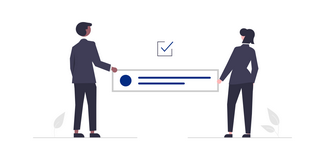
4. Lack of Partnering Ethos
Has your current legal support service vendor left you feeling as if they are interested only in selling you a service? Do they only react to your needs as issues crop up?
If that sounds like your status quo, then the status quo is not what you deserve. You deserve better.
For law firms that want to remain competitive in the 21st century “better” is a strategic partner. There are several characteristics that distinguish a strategic partner from a vendor who is content to just run your credit card.
Here are several strategic partner characteristics that add value to your law firm:
- Works with you proactively
- Seeks to add value to your firm.
- Provides data and reports for transparency and accountability.
- Inquires about your firm’s goals and objectives.
- Concentrates on strategic business outcomes such as cost and process efficiencies as well as risk management.
- Constantly thinks of new and different ways to do things.
- Focuses on a long-term partnership.
- Strives to be a preferred vendor for your firm.
If you’d like to fully understand the differences between strategic partners and transactional partners, read It’s Time for Law Firms to Think Differently About How They Use Litigation Support Service Providers.
5. No Pricing Transparency
Ever wondered why some legal support services providers bury fees in fine print, or quietly tack on a surcharge to inflate a price that originally seemed like a great deal? You’re not alone.
No one likes hidden fees.
As trouble signs go, hidden fees are worrisome because they can cause you to go over budget. It’s time to take your business elsewhere if you’ve experienced either of the following with your current vendor:
- Fees are not shown in the workflow of the portal during the ordering process
- Vendor does not provide in-depth itemized invoices. This includes available payment methods, amount owed, and unique invoice reference numbers.

You’re ready to switch. This is how to qualify and interview alternate providers.
You’ve decided to make your move and, if you choose wisely, good things lie ahead. Your next step is to evaluate prospective vendors with specific questions about the specialized services they provide.
To shorten the distance between you and your ideal match, here are the questions you need to ask.
Pricing
Ask about hidden fees. Make it clear you want to understand every charge for which the firm will be billed. They should offer a way for you to calculate your charges up front.
Likewise, ask them to describe their billing process and whether they provide in-depth, itemized invoices. No ambiguity, no exceptions.
Customer Service
How many ways you can contact the prospective vendor’s customer support? Find out if they offer live chat, email, and phone support.
You’ll also want to know how frequently you can expect updates about document status. Ask if you will have a dedicated account manager.
Filing Success
Two questions matter:
1. What is the vendor’s acceptance rate with the courts?
2. Can you benchmark your acceptance rates and rejection rates against the rest of the industry? No data, no deal.

Ease of Use
Request a demo and put the system through its paces while you’re at the controls.
Ask whether the vendor returns court-stamped documents quickly and reliably. Make them explain what that means in terms of hours, days, or weeks.
Does the vendor offer custom reports and analytics? This case study shows the importance of these reports and how their data can aid growth and protect your revenues.
Scalability
Can the vendor handle your work volume? Ask about document review, physical filing, eFiling, service of process, and key services you use in quantities you need.
Don’t end the interview until you know exactly how many California courts the vendor eFiles into.
Concerned About Making the Right Choice? Read These to Stop Worrying.
• A Complete Checklist for Selecting a Certified eFiling Service Provider
• The Ultimate Guide for Process Serving
Get referrals
In the rush to find a new vendor this crucial part of the decision-making process may fall off the radar.
Here are three questions tailored to guide conversations with a vendor about referrals. A reputable vendor will answer them all.
- Do you have a well-documented performance and acceptance rate with the courts?
- Can you provide references from any of the courts’ electronic filing manager (EFM) vendors that integrate with your offering?
- Do you have any case studies that spotlight your work?

Is Your New Vendor a Keeper?
You’ve done your due diligence, checked the boxes, and found a vendor that looked like partnership material. You’ve worked together for a while and you want to know whether it was the right move.
Here’s the answer: Did the switch fix a pain point or problem?
If poor eFiling performance was one reason you switched vendors, you can gauge the success of your move by determining whether eFiling turnaround times and service of process success rates have improved, stayed the same, or gotten worse.
Monthly performance metrics from your vendor can help make that determination. The right provider will include granular data in those metrics that allow you to track:
- eFiling orders by county.
- Service of process orders by service level and pricing zone.
- Number of documents served (by days elapsed).
- Proofs of service returned (by days elapsed).
- Types of orders placed.
Did You Get Any Face Time?
Best-in-class vendors are willing to meet and provide regular updates about itself and the courts. Likewise, a high-performing vendor will provide quarterly business reports that include an order summary report and a recap of its relationship with the firm.
The vendor should conduct review meetings with the law firm to monitor new developments, strategize, and make sure the firm is happy with the quality of service.
This is how the best vendors proactively keep themselves and the law firm accountable to each other.

Here’s a Shortcut
We’ve given you all the tips and tools to begin your vendor evaluation. But since you’re here, why not begin the search with Rapid Legal?
With Rapid Legal you’ll get the advantage of a technology infrastructure second to none and access to every eFiling court in California. More importantly, you’ll get a strategic partner dedicated to transparency and accountability.
That’s not just talk. We back it up with one powerful sentence published proudly on our website:
If service is not done right, it’s free.
Want to know more? Contact a Rapid Legal account executive to book a demo or schedule a call.

